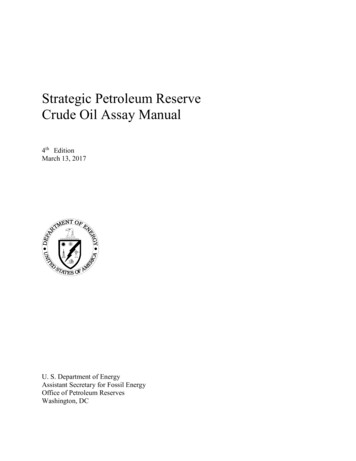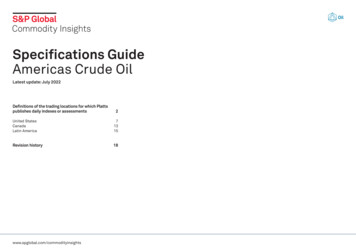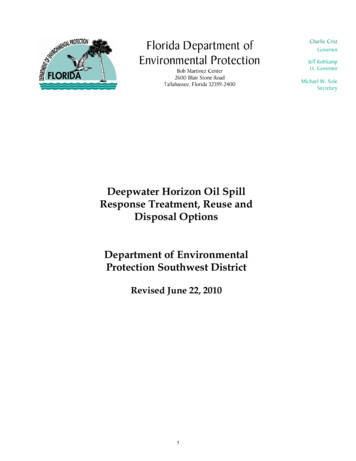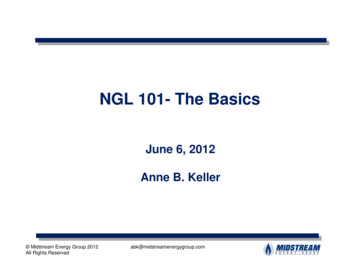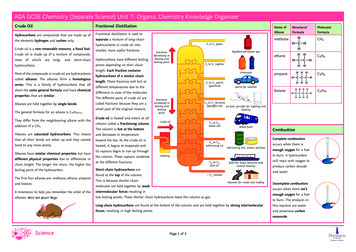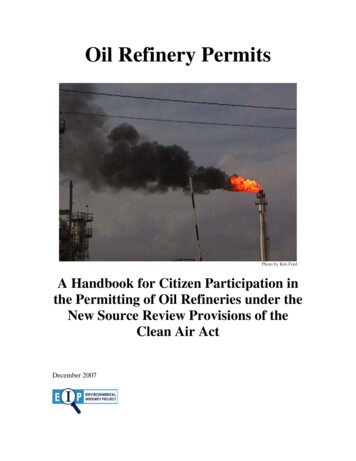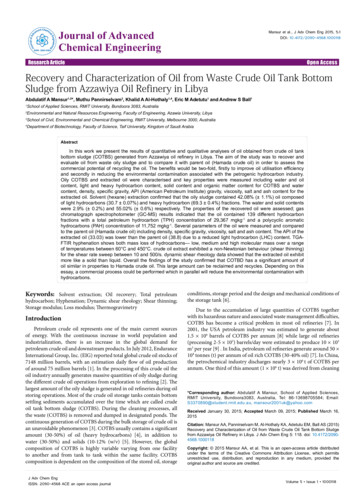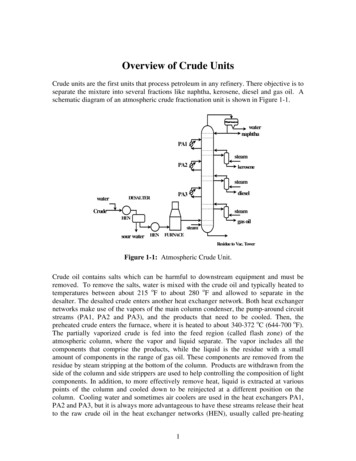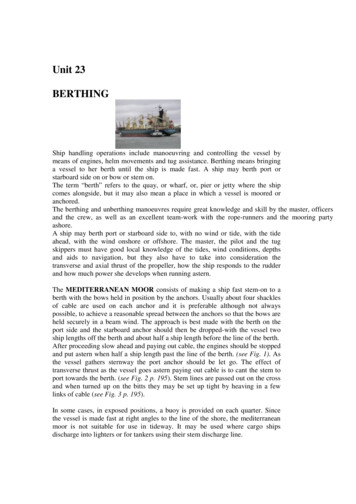
Transcription
ENERGYLight Sweet Crude Oil (WTI)Futures and OptionsThe world’s most liquid crude oil benchmark.How the world advances1
As the world’s leading and most diverse derivatives marketplace, CME Group is where the world comes to manage risk. CME Groupexchanges offer the widest range of global benchmark products across all major asset classes, including futures and options based oninterest rates, equity indexes, foreign exchange, energy, agricultural commodities, metals, weather and real estate. CME Group bringsbuyers and sellers together through its CME Globex electronic trading platform and its trading facilities in New York and Chicago.CME Clearing, an industry-leading central counterparty clearing provider, offers clearing and settlement services for exchange-tradedand over-the-counter derivatives. Together, CME Group’s products and services ensure that businesses everywhere can substantiallymitigate counterparty credit risk in both on-exchange and over-the-counter derivatives markets.The Energy MarketplaceIn 2008, NYMEX became part of CME Group. Together, we offer the most extensive and liquid energy complex in the world, includingLight Sweet Crude Oil (WTI), Natural Gas (Henry Hub), petroleum and electricity products. Many of our contracts are benchmarks thatset the price for these resources worldwide. From the world’s largest industrial companies to financial institutions, our diverse universeof participants clear an average daily volume of 1.9 million energy contracts every day on CME Globex, through CME ClearPort or on ourtrading floor — making CME Group the world’s leading energy marketplace.Key Crude Oil and Refined Product ContractsFuturesOptions»»Light Sweet Crude Oil (WTI) (CL)»»Light Sweet Crude Oil (WTI) (LO)»»E-mini Light Sweet Crude Oil (WTI) (QM)»»Light Sweet Crude Oil (WTI) Average Price (AO)»»Brent Crude Oil Last Day (BZ)»»Light Sweet Crude Oil (WTI) Look-Alike (LC)»»Brent (ICE) Calendar Swap (CY)»»Light Sweet Crude Oil (WTI) 1 Month Calendar Spread (WA)»»WTI – Brent (ICE) Bullet Swap (BY)»»Light Sweet Crude Oil (WTI) Daily (CD)»»Dubai Crude Oil Calendar Swap (Platts) (DC)»»Brent Crude Oil (OS)»»Heating Oil (HO)»»Brent Look-Alike Crude Oil (BE)»»RBOB Gasoline (RB)»»Brent Crude Oil Average Price (BA)»»European Gasoline Euro-bob Oxy NWE Barges Swap (7H)»»Brent Crude Oil Last Day Financial 1 Month Calendar»»New York Harbor Ultra-Low Sulfur Diesel (ULSD) (LH)»»Gulf Coast ULSD (Platts) Up-Down Spread Swap (LT)»»WTI – Brent Crude Oil Spread (BV)»»Gulf Coast No. 6 Fuel Oil 3.0% (Platts) Swap (MF)»»Heating Oil (OH)»»Singapore Fuel Oil 180 cst Swap (UA)»»Heating Oil Average Price (AT)»»Singapore Gasoil Swap (Platts) (SG)»»New York Harbor Gasoline Blendstock (RBOB) (OB)»»RBOB Gasoline Average Price (RA)»»Gasoil Average Price (F7)Spread (9C)
A History of Light Sweet Crude Oil (WTI)Futures and OptionsEvery day, around the world, virtuallyresulting in newfound price volatility. Seeingaround the clock, Light Sweet Crudea new need in the market, the New YorkOil (WTI) futures and options marketsMercantile Exchange (NYMEX), now a partaverage 1,000,000 contracts traded —of CME Group, introduced an innovative toolthat translates to one billion barrels ofto provide the oil industry with an effectiveoil. Whether traded on the CME Globexhedge against price volatility — WTI futures.electronic trading platform, on the tradingfloor in New York or cleared through CMEClearPort, WTI futures and options representvital price risk management opportunitiesfor global crude oil suppliers and consumers.Within three years of contract launch,overproduction by the Organization ofPetroleum Exporting Countries (OPEC)dropped oil prices from 32.00 a barrel toHowever, this was not always the case. 9.75 in just five months. As a result, morePrior to the disruptive price shocks of thecontract as a risk management tool. In the1970’s, oil prices were generally stable,press, Exchange-price quotes began to takefollowing traditional, less complicated,precedence over previously accepted pricesupply/demand economics. During thequotations.1970’s, geopolitical issues like the 1973 YomKippur War and the Iranian Revolution of1979 injected radical uncertainty into themarket and shattered price stability, leadingto continuing price increases throughoutmuch of the 1970’s and into the early1980’s. Concurrently, U.S. government priceand allocation controls effectively preventedthe market from responding naturally toany weakness in demand, allowing oilproducing nations to keep upward pressureon prices until controls were lifted in early1981. Over the next two years, the marketbegan responding to supply and demand,and more institutions turned to the WTIFive years later, when Iraq invaded Kuwait inAugust of 1990, the risk of war threatenedto cut off nearly one quarter of the world’soil supply. Prices soared and trading onthe Exchange rallied as oil producers andWTI futures andoptions represent vitalprice risk managementopportunities.secular market trend has been punctuatedby dramatic swings. The financial crisisof 2008, along with the ensuing globalrecession, brought about the sharpestrecorded decline in demand for crude oil.Likewise, massive political unrest acrossthe Middle East in 2011 has led to greatervolatility and unpredictability. In timesof uncertainty, the market flocks to WTI,and steady increases in contract volumehave further reinforced WTI’s function asa global benchmark for crude oil prices. Ascrude oil markets continue to experiencethese changes, the value of hedging withWTI futures has never been greater.buyers sought to sustain appropriate levelsof risk management in a time of extremeuncertainty.Since 2004, global production capacityhas expanded continuously, but oil priceshave experienced a secular rise as awealthier world economy’s appetite forcrude oil outpaces this expansion. Yet this1
Light Sweet Crude Oil (WTI) Futures and OptionsWhen the World Asks, “What’s the Price ofCrude Oil?” WTI is the Answer.WTI (West Texas Intermediate — a lightWTI contract continues to be the mostThe Exchange futures contract provides asweet crude oil stream) consists of aliquid benchmark for the global price of oil.basic unit of account in increments of 1,000blend of several U.S. domestic streams ofApproximately 20 million barrels per day ofbarrels, which gives companies the ability tolight sweet crude oil. The delivery point inNorth American crude oil sales are pricedcustomize the size of their futures position toCushing, Oklahoma, is a vital transshipmentusing our WTI contract as the benchmarkmatch the size of their import cargo. Further,point with many intersecting pipelines,— ensuring it remains the most efficientthere is a highly liquid over-the-counter (OTC)storage facilities and easy access to refinershedging tool for hundreds of internationalderivatives market that is tied to the deepand suppliers. Crude oil flows inbound tocommercial oil companies.liquidity of our WTI futures contract, allowingCushing from all directions and outboundthrough dozens of pipelines. Naturally, thisstrategic position led to WTI’s developmentmarket participants to manage their oil priceAdditionally, in the international crude oilrisk with customized OTC cleared instruments.market, physical oil is transported fromsources as near as Mexico and as far asWTI’s centrality to these markets meansSaudi Arabia in large cargo ships, whosethat its forward price curve, aggregatingcrude oil futures in 1983.capacity ranges from smaller cargoes offutures prices up to nine years forward inapproximately 500,000 barrels to the largesttime, is a mainstay reference on individual,As a pricing mechanism for physicalcargoes of 4 million barrels in ships calledorganizational and macroeconomic scales. Itdelivery of crude oil in North America, WTIUltra-Large Crude Carriers. Typically, theseenables individual investors to strategicallyis firmly rooted in the physical market.oil cargo transactions are hedged usingdiversify investment portfolios, refiners andBecause of the unique immediacy, breadth,tools directly derived from the price of ourother operations using oil as a direct input toand depth of pricing and inventoryWTI contract, which allows commercial oilanticipate supply-demand fluctuations, anddata supplied by the U.S. government,companies to lock in their price for importedeconomists to calibrate the value of nationaland because onshore North Americanoil in varying size increments.oil reserves.as a significant physical market pricereference well before the Exchange listedproduction has been a key driver of growingglobal crude oil supply over the pastdecade, no other crude oil benchmark moreCrude Oil Month-End Settlement Priceaccurately reflects the supply and demandSpot Settlementdynamics of the market.160.00In the U.S. market, physical crude oil is140.00typically bought and sold in incrementsof 1,000 barrels for delivery via pipeline2Jan 11Sep 10Jan 10May 10Sep 09Jan 09May 09Sep 08May 08Jan 08Sep 07May 07Jan 07one-to-one correspondence is why ourSep 060.00the futures and physical markets. ThisJan 0620.00instantaneous price convergence betweenMay 06commercial transactions, offering a nearlySep 0540.00May 05that is tailor-made for standard U.S.60.00Jan 05of 1,000 barrels is a convenient unitSep 04Consequently, our futures contract size80.00May 04barrels per day for the entire month.100.00Jan 04commercial contract specifying 1,000 per barreleach day of the month, with the standard120.00
cmegroup.com/wtiWho Uses the Crude OilFutures Market?A WTI futures contract is the most liquid,marketers can sell futures to lock in pricesInvestors and Speculatorstransparent oil-trading instrument availablefor future delivery, protecting the value ofWith no intention of buying or selling actualto the industry today. Oil is traded worldwidefuture crude oil sales.commodities, investors and speculators tryand the market can be affected by eventsto make money by buying futures contractsOther Oil Industry Participantsanywhere at anytime. To help manage thatat a low price and selling back at a higherWTI futures can be used as a hedgingrisk, market participants can trade WTIprice or by selling futures contracts at a highinstrument to shift exposure to price risk.contracts on CME Globex virtually 24 hoursprice and buying back lower. However, theyRefiners, traders, and marketers will buya day. OTC traders can also have the securityalso take on the risk that prices may changefutures to protect against their exposure toof clearing privately negotiated transactionsthrough CME ClearPort.rising cash market prices.The versatility and wide acceptance of theProfessional Energy Tradersto their disadvantage.Trading listed heating oil and unleadedbenchmark futures contract serves thegasoline contracts in tandem with crudediverse and complex needs of an array ofcrude oil marketplace participants, including:oil futures can lock in the “crack spread,” orCommercial Enterprises with aDirect Stake in the Price of Oilbetween crude oil and refined products. TheThe contract can be a valuable hedgingheating oil/crude oil and gasoline/crude oilinstrument. As a safegaurd against fallingcrack spreads, as well as on each individualcash market prices, producers, traders andfutures contract.the theoretical cost of the refining marginExchange also offers options contracts on theCrude Oil Monthly Volume and Month-End Open InterestVolumeOpen Interest1.6161.4141.2121.0100.880.660.440.2Jul 11Jan 11Jul 10Jan 10Jul 09Jan 092Jul 08Monthly Volume in Millions18Month-End Open Interest in Millions1.8203
cmegroup.com/wtiThe Benefits of Trading WTIwith CME GroupIncreasing Flexibility with Exchange ofFutures for PhysicalsSafe and Secure – Central Counterparty ClearingTo allow market participants to more easily manage crude oil pricemanagement services — giving you the security and confidencerisk, the Exchange provides a trading instrument to complementmarket participants need to operate, invest and grow. For everythe futures contract known as Exchange of Futures for Physicalstrade completed on our Exchange — whether on the floor, on the(EFP). An EFP allows the exchange of a futures position for a physicalscreen or using off-exchange transactions cleared throughposition in the underlying cash market. Such a contract is optimal toCME ClearPort — CME Clearing acts as the counterparty to everydeliver or receive crude oil from a specifically desired counterparty,trade to substantially mitigate counterparty credit risk and virtuallythat does not necessarily conform to the delivery location or gradeguarantee the financial soundness of both parties. By being at thespecification of our WTI futures contract. EFPs, which can benefitcenter of every transaction, we can protect everyone’s interest andboth sides of a transaction, account for most of the deliveries madeensure the integrity of the marketplace.We lead the industry in providing a comprehensive set of risk-against the futures contract. Rather than accepting a randomlymatched partner, as would occur through normal clearing procedures,EFPs allow traders to choose their trading partners while retaininganonymity in the market at large.KEY A DVA N TAG ES OF C ME C L E AR I NGCentral Counterparty GuaranteePerformance Bond RequirementsWhether you trade live on the floor, electronically on CME GlobexAll of our customers are required to put up a “good faith deposit,”or clear privately negotiated trades through CME ClearPort, youror performance bond, to cover the maximum likely loss acredit risk is substantially mitigated as CME Clearing becomesposition could suffer. In turn, our clearing member firms mustthe buyer to every seller and the seller to every buyer.post to CME Clearing at least the maintenance performance 8 Billion in Safety and Soundness*bonds for all positions carried.In more than 100 years of trading, CME Clearing has never hadTwice Daily Mark-To-Market Processa default or a loss of customer funds resulting from failure of aAccumulation of debts/losses is limited and transparency isclearing firm.achieved as CME Clearing marks your futures and optionsSegregation of Customer Fundspositions to market twice daily.Your funds are not subject to creditor claims against your24-Hour Monitoring by an Experienced Risk-Management Teamclearing firm should it become financially unstable or insolvent,A global team of clearing and auditing professionals uses aand can be transferred to another clearing firm if needed.variety of sophisticated tools to carefully observe risk 24 hours aday, seven days a week.* Financial safeguards and collateral levels cited are as of Dec. 31, 2010.5
Light Sweet Crude Oil (WTI) Futures and OptionsWTI Options: Versatility DefinedExpanding Risk ManagementOpportunities with CrudeOil Optionsis obligated to perform, should a buyerholder may choose to allow his optionsexercise the option. If options expire withoutcontract to expire worthless and isbeing exercised, the options seller profits byotherwise able to participate fully in anyWTI options, introduced in 1986, provide yetthe amount of the premium.favorable price move.another hedging instrument for oil tradersto increase their flexibility in managingbusiness risk.If prices are expected to rise, a trader canrefiner the ability to buy farther forward toThe Exchange offers many types of crudemeet his crude oil acquisition requirements,oil options, but in the most liquid variety, thewhile averting the risk of a price increase.holder of an options contract has the right,but not the obligation, to buy or sell a futurescontract at a specified time in exchangefor a one-time payment, or premium. Theseller of an option, on the other hand, has anobligation to buy or sell a futures contract, if aholder of an option chooses to exercise it.All varieties of options exist in two basicforms: calls and puts. A call gives theholder the right, but not the obligation, tobuy futures at a specific price (the strikeor exercise price) within a specific periodWTI options provideanother hedginginstrument forflexibility in managingbusiness risk.buy a call, which, for example, would give aIf crude oil prices are expected to fall, atrader may consider puts, which permit theholder to sell forward crude oil production,protecting his selling price in the event of amarket price decline.A Diverse Options Slate forDiverse Hedging NeedsBecause of the sheer size of the crude oilmarket and the WTI benchmark’s centralUnlike futures, which must either beliquidated or held to delivery, the holder ofan options contract has a third alternative:if the futures price does not move enough tomake exercising the option worthwhile,or moves in the opposite direction, theof time. A put gives the holder the right,position within it, the Exchange offers asophisticated array of option varieties. Eachaugments the flexibility of various hedgingactivities, while affording speculatorsa maximum breadth of strategies toparticipate in an enormously liquid market.but not the obligation, to sell futures at afunction similar to that of an insurancecompany. He collects the premium and650020Month-End Open Interest in MillionsAn options seller (or writer) performs a4Jan 11would be purchased.100Jan 10to protect against a price decrease, a put6Jan 09increase, the hedger would purchase a call;150Jan 08period. To protect against the risk of a price8Jan 07contract’s price risk for the designated time200Jan 06buyer obtains protection against a futures10Jan 05for a one-time, up-front premium, theJan 04purchasing an insurance policy: in returnOpen InterestVolume250Jan 03Buying a call or a put is similar toWTI Options Complex Monthly Average Daily Volume and Month-End Open InterestMonthly Average Daily Volume in Thousandsspecific price for a specific period of time.
cmegroup.com/wtiCrude oil options for ma ximum fle xibilityEuropean-Style WTI OptionsCalendar Spread WTI OptionsAlso known as look-alike or “vanilla” options, this simplest varietyAlso called time spread options, this highly popular type of option:of standard options:»»»»»»»»»»at expirationmay be exercised into cash settlement upon expiration onlyis priced based on the underlying contract’s expected price»»futures positions, one long and one short, on a nearby and atends to trade at a discount to American-style optionsmore distant monthif settled financially, protects the writer from any unexpectedAmerican-Style WTI Options»»expectations for short- and long-term supply-demandmay be exercised into its underlying physically settled WTIfluctuations.affords the opportunity to earn interest on premiumsCrack Spread WTI Optionsrecovered from early exerciseNamed for the “cracking” process that converts crude oil intois the more widely traded standard crude oil option typerefined products, this option type:permits hedgers with a physical oil position to respond more»»rapidly to price fluctuationsAverage Price WTI Optionsmay be financially settled into its underlying WTI calendarswap only at expiration»»is priced based on its underlying contract’s expected averageprice over one month»»»»one long and one short, for the same contract month*»»margins, based on divergent expectations of supply-demandfluctuations for crude oil versus refined productsShort-Term WTI Optionsthe month prior to expirationA low-cost solution for targeting specific nearby points in time,option variety:is priced based on the average price of an underlying strip ofcontracts spanning several monthscosts less than buying separately expiring options for eachmonth at the same strike price»»this variant of the European option:»»»»may be cash settled upon expiration onlyexpires up to five business days forward following the firstcycle week, with a new contract listed another five businessmay be exercised into its underlying financially settledfutures contracts only at expiration»»provides refineries with a hedging tool to protect their profitmirrors the oil industry’s daily commercial activities acrossSometimes referred to as swaptions or “one-timers”, this»»like calendar spread options, enables market participants to beton growth, contraction or inversion of the underlying spread»»reduces volatility risk and often trades at a discount toOptions on WTI Futures Strips»»is priced based on the spread between one underlying WTIfutures and one underlying refined product futures position,American-style options»»may be exercised into its underlying futures positions onlyat expirationOften labeled Asian or arithmetic Asian options, this type of option:»»allows commercial participants in the oil industry to hedgeagainst the costs of inventory storage based on divergentfutures contract prior to expiration»»»»enables market participants to bet on growth, contraction orinversion of the spread»»A more flexible variant of the European type, this standard option:»»is priced based on the spread between two underlying WTIupon expirationexercise into futures by the holder»»may be exercised into its underlying futures positions onlydays forward listed in its place»»provide a flexible, secure alternative to OTC trades thatcapitalize on sudden market movements»»enables physical market participants to respond nimbly tonatural disasters and geopolitical disruptionsenables producers and consumers operating on a multi-periodtime horizon to lock in a single premium and strike price*Refined product contracts typically terminate ten days after the associated crude oil contract.7
Light Sweet Crude Oil (WTI) Futures and OptionsWTI Contract SpecificationsLight Sweet Crude Oil Futures8CodeCLVenueCME Globex, CME ClearPort, Open Outcry (New York)Hours(All Times areNew York Time/ET)CME Globex and CME Clearport: Sunday – Friday 6:00 p.m. – 5:15 p.m. (5:00 p.m. – 4:15 p.m. Chicago Time/CT)with a 45-minute break each day beginning at 5:15 p.m. (4:15 p.m. CT)Open Outcry: Monday – Friday 9:00 a.m. – 2:30 p.m. (8:00 a.m. – 1:30 p.m. CT)Contract Unit1,000 barrelsPricing QuotationU.S. dollars and cents per barrelMinimumFluctuation 0.01 per barrelTermination ofTradingTrading in the current delivery month shall cease on the third business day prior to the twenty-fifth calendar day of the monthpreceding the delivery month. If the twenty-fifth calendar day of the month is a non-business day, trading shall cease on the thirdbusiness day prior to the last business day preceding the twenty-fifth calendar day. In the event that the official Exchange holidayschedule changes subsequent to the listing of a Crude Oil futures, the originally listed expiration date shall remain in effect. In theevent that the originally listed expiration day is declared a holiday, expiration will move to the business day immediately prior.Listed ContractsYear and the next five years; in addition, the June and December contract months are listed beyond the sixth year. Additional monthswill be added on an annual basis after the December contract expires, so that an additional June and December contract would beadded nine years forward, and the consecutive months in the sixth calendar year will be filled in. Additionally, trading can be executedat an average differential to the previous day’s settlement prices for periods of two to 30 consecutive months in a single transaction.These calendar strips are executed during open outcry trading hours.Settlement TypePhysicalTrading atSettlement (TAS)Trading at settlement is available for spot (except on the last trading day), 2nd, 3rd and 7th months and subject to the existing TASrules. Trading in all TAS products will cease daily at 2:30 p.m. Eastern Time. The TAS products will trade off of a “Base Price” of 0 tocreate a differential (plus or minus 10 ticks) versus settlement in the underlying product on a 1 to 1 basis. A trade done at the BasePrice of 0 will correspond to a “traditional” TAS trade which will clear exactly at the final settlement price of the day.Delivery(A) Physical delivery shall be made F.O.B. at any pipeline or storage facility in Cushing, Oklahoma, with pipeline access to TEPPCO,Cushing storage or Equilon Pipeline Company LLC, Cushing Storage. Delivery shall be made in accordance with all applicable Federalexecutive orders and all applicable Federal, State and local laws and regulations.(B) At buyer’s option, such delivery shall be made by any of the following methods: (1) By interfacility transfer (“pumpover”) into adesignated pipeline or storage facility with access to seller’s incoming pipeline or storage facility. (2) By in-tank transfer of title to thebuyer without physical movement of product; if the facility used by the seller allows such transfer, or by in-line transfer or book-out ifthe seller agrees to such transfer.Grade and QualitySpecificationsPhysical delivery shall consist of light, sweet crude oil that meets the requirements of the TEPPCO domestic common streamdesignation, with maximum sulfur content of 0.42% or less using ASTM D-4294, and gravity between 37 and 42 degrees API usingASTM D-287. The complete specifications can be viewed in the CME Rulebook under section 200.12.Rulebook Chapter200Exchange RuleThese contracts are listed with, and subject to, the rules and regulations of NYMEX.
cmegroup.com/wtiLight Sweet Crude Oil OptionContract NameLight Sweet Crude Oil OptionUnderlying FuturesLight Sweet Crude Oil Futures (CL)Product SymbolLOVenueCME Globex, CME ClearPort, Open Outcry (New York)Hours(All Times areNew York Time/ET)CME Globex and CME Clearport: Sunday – Friday 6:00 p.m. – 5:15 p.m. (5:00 p.m. – 4:15 p.m. Chicago Time/CT)with a 45-minute break each day beginning at 5:15 p.m. (4:15 p.m. CT)Open Outcry: Monday – Friday 9:00 a.m. – 2:30 p.m. (8:00 a.m. – 1:30 p.m. CT)Contract UnitA Light Sweet Crude Oil Put (Call) option traded on the Exchange represents an option to assume a short (long) position in theunderlying Light Sweet Crude Oil futures traded on the Exchange.Price QuotationU.S. dollars and cents per barrelOption StyleAmericanMinimumFluctuation 0.01 per barrelExpiration of TradingTrading ends three business days before the termination of trading in the underlying futures contract.Listed ContractsCrude oil options are listed nine years forward using the following listing schedule: consecutive months are listed for the current yearand the next five years; in addition, the June and December contract months are listed beyond the sixth year. Additional months willbe added on an annual basis after the December contract expires, so that an additional June and December contract would be addednine years forward, and the consecutive months in the sixth calendar year will be filled in.Strike PricesTwenty strike prices in increments of 0.50 per barrel above and below the at-the-money strike price, and the next 10 strike pricesin increments of 2.50 above the highest and below the lowest existing strike prices for a total of at least 61 strike prices. The at-themoney strike price is nearest to the previous day’s close of the underlying futures contract. Strike price boundaries are adjustedaccording to the futures price movements.Settlement TypeExercise into FuturesRulebook Chapter310Exchange RuleThese contracts are listed with, and subject to, the rules and regulations of NYMEX.9
WTI Average Price OptionUnderlying FuturesLight Sweet Crude Oil Futures (CL)Product SymbolAOVenueCME ClearPort, Open Outcry (New York)Hours(All Times areNew York Time/ET)CME ClearPort: Sunday – Friday 6:00 p.m. – 5:15 p.m. (5:00 p.m. – 4:15 p.m. Chicago Time/CT)with a 45-minute break each day beginning at 5:15 p.m. (4:15 p.m. CT)Open Outcry: Monday – Friday 9:00 a.m. – 2:30 p.m. (8:00 a.m. – 1:30 p.m. CT)Contract UnitOn expiration of a call option, the value will be the difference between the average daily settlement price during the calendar month ofthe first nearby underlying Light Sweet Crude Oil futures and the strike price multiplied by 1,000 barrels, or zero, whichever is greater.On expiration of a put option, the value will be the difference between the strike price and the average daily settlement price during thecalendar month of the first nearby underlying Light Sweet Crude Oil futures multiplied by 1,000 barrels, or zero, whichever is greater.Price QuotationU.S. dollars and cents per barrelOption StyleAverage Price – non early exercisable optionMinimumFluctuation 0.01 per barrelExpiration of TradingTrading ends the last business day of the calendar month.Listed Contracts72 consecutive monthsStrike PricesTwenty strike prices in increments of 0.50 (50 ) per barrel above and below the at-the-money strike price, and the next 10 strikeprices in increments of 2.50 above the highest and below the lowest existing strike prices for a total of at least 61 strike prices. Theat-the-money strike price is nearest to the previous day’s close of the underlying futures contract. Strike price boundaries are adjustedaccording to the futures price movements. In addition, options trading can be conducted in strike price increments of 0.01.Settlement TypeFinancialRulebook Chapter341Exchange RuleThese contracts are listed with, and subject to, the rules and regulations of NYMEX.WTI Look-Alike OptionUnderlying FuturesLight Sweet Crude Oil Futures (CL)Product SymbolLCVenueCME Globex, CME ClearPort, Open Outcry (New York)Hours(All Times areNew York Time/ET)CME Globex and CME Clearport: Sunday – Friday 6:00 p.m. – 5:15 p.m. (5:00 p.m. – 4:15 p.m. Chicago Time/CT)with a 45-minute break each day beginning at 5:15 p.m. (4:15 p.m. CT)Open Outcry: Monday – Friday 9:00 a.m. – 2:30 p.m. (8:00 a.m. – 1:30 p.m. CT)Contract UnitOn expiration of a call option, the value will be the difference between the settlement price of the underlying Light Sweet Crude Oilfutures and the strike price multiplied by 1,000 barrels, or zero, whichever is greater. On expiration of a put option, the value will bethe difference between the strike price and the settlement price of the underlying Light Sweet Crude Oil futu
Futures and Options Every day, around the world, virtually around the clock, Light Sweet Crude Oil (WTI) futures and options markets average 1,000,000 contracts traded — that translates to one billion barrels of oil. Whether traded on the CME Globex electronic trading platform, on the trading floor in New York or cleared through CME
